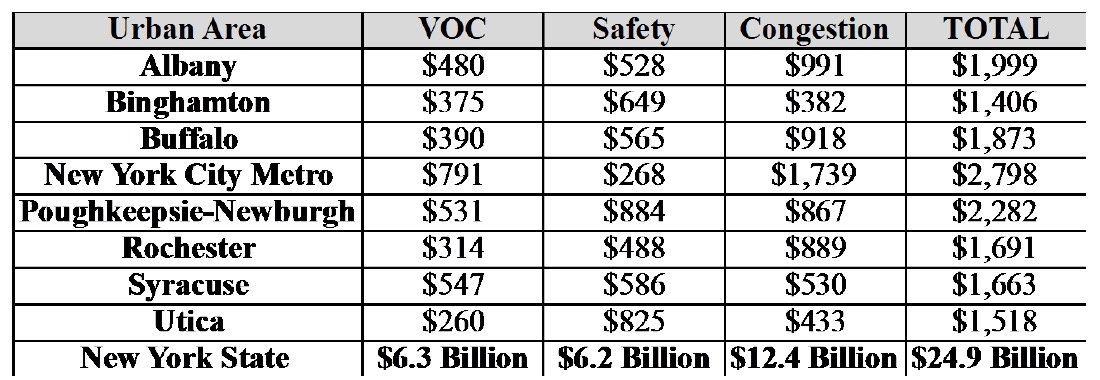TRIP
Executive Summary
Eight years after the nation suffered a significant economic downturn, New York’s economy continues to rebound. The rate of economic growth in New York, which will be greatly impacted by the reliability and condition of the state’s transportation system, continues to have a significant impact on quality of life in the Empire State.
An efficient, safe and well-maintained transportation system provides economic and social benefits by affording individuals access to employment, housing, healthcare, education, goods and services, recreation, entertainment, family, and social activities. It also provides businesses with access to suppliers, markets and employees, all critical to a business’ level of productivity and ability to expand. Conversely, reduced accessibility and mobility – as a result of traffic congestion, a lack of adequate capacity, or deteriorated roads, highways, bridges and transit facilities – diminishes a region’s quality of life by reducing economic productivity and limiting opportunities for economic, health or social transactions and activities.
With a wide based economy including finance, manufacturing, technology, communications, printing, entertainment, shipping, publishing, agriculture and tourism, the quality of New York’s transportation system will play a vital role in the state’s level of economic growth and quality of life.
In this report, TRIP looks at the top transportation issues faced in New York as the state addresses its need to modernize and maintain its roads, highways, bridges and transit systems.
In December 2015, Congress passed and the president signed into law a long-term federal surface transportation program that includes modest funding increases and allows state and local governments to plan and finance projects with greater certainty through 2020. The Fixing America’s Surface Transportation Act (FAST Act) provides approximately $305 billion for surface transportation with highway and transit funding slated to increase by approximately 15 and 18 percent, respectively, over the five-year duration of the program. While the modest funding increase and certainty provided by the FAST Act are a step in the right direction, , the funding falls far short of the level of needed to improve conditions and meet the nation’s mobility needs and fails to deliver a sustainable, long-term source of revenue for the federal Highway Trust Fund.
COST TO NEW YORK MOTORISTS OF DEFICIENT ROADS
An inadequate transportation system costs New York motorists a total of $24.9 billion every year in the form of additional vehicle operating costs (VOC), congestion-related delays and traffic crashes.
- TRIP estimates that New York roadways that lack some desirable safety features, have inadequate capacity to meet travel demands or have poor pavement conditions cost the state’s residents approximately $24.9 billion annually in the form of additional vehicle operating costs (including accelerated vehicle depreciation, additional repair costs, and increased fuel consumption and tire wear), the cost of lost time and wasted fuel due to traffic congestion, and the financial cost of traffic crashes.
- TRIP has calculated the average cost to drivers in the state’s largest urban areas as a result of driving on roads that are deteriorated, congested and lack some desirable safety features. The chart below details the costs to drivers in the state’s largest urban areas.
POPULATION AND ECONOMIC GROWTH IN NEW YORK
Population and economic growth in New York have resulted in increased demands on the state’s major roads and highways, leading to increased wear and tear on the transportation system.
- New York’s population reached approximately 19.7 million residents in 2014, an 18 percent increase since 1990.
- New York had 11.2 million licensed drivers in 2013.
- Vehicle miles traveled (VMT) in New York increased by 21 percent from 1990 to 2013 –from 106.9 billion VMT in 1990 to 129.7 billion VMT in 2013.
- Vehicle miles of travel in New York for the first ten months of 2015 were 3.3 percent higher than the first ten months of 2014. During the first ten months of 2015, U.S. vehicle miles of travel were 3.4 percent higher than the first ten months of 2014.
- By 2030, vehicle travel in New York is projected to increase by another 15 percent.
- From 1990 to 2013, New York’s gross domestic product, a measure of the state’s economic output, increased by 46 percent, when adjusted for inflation. U.S. GDP increased 65 percent during this time.
Download full version (PDF): New York’s Top Transportation Issues
About TRIP
www.tripnet.org
Founded in 1971, TRIP ® of Washington, DC, is a nonprofit organization that researches, evaluates and distributes economic and technical data on surface transportation issues. TRIP is sponsored by insurance companies, equipment manufacturers, distributors and suppliers; businesses involved in highway and transit engineering and construction; labor unions; and organizations concerned with efficient and safe surface transportation.







 RSS Feed
RSS Feed